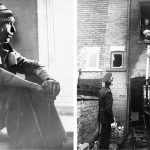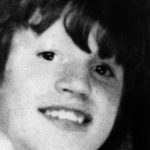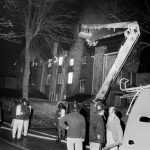
Episode 22 – Serial Killer – Bruce George Peter Lee
The Hasties
It all started on December 4, 1979. The night had been quiet at Selby Street in the small English port city of Hull. In house number 12, 34-year-old Edith Hastie slept peacefully with her four sons, Charlie, 15, Paul, 12, Thomas, 9, and 8-year-old Peter, blissfully unaware of the chaos that would soon emerge.
Only an hour or so had passed since Edith had kissed her sons goodnight when she suddenly woke up. Edith could not immediately say what had awoken her, but she knew something was terribly wrong—perhaps it was the mother’s sixth sense telling her to get up and go to check on the children. It was then that Edith smelled the smoke, and as she stepped outside onto the landing, she saw tall flames licking the wooden stairs. The whole downstairs was on fire. Edith then ran to wake up her eldest, Charlie, who joined her in an effort to save Thomas, who had muscular dystrophy and would have had difficulty escaping by himself. Due to his condition, Thomas slept in the same bedroom as his mother, but when Edith and Charlie tried to get to him, flames and smoke pushed them back—there was nothing they could do. So, the mother and son returned to the front bedroom, where Charlie helped Edith out of the window. There was a big drop, about 15-foot, but broken bones were a small price to pay for one’s life. Edith was lucky and only injured her ankle as it hit the concrete path outside her home. She then turned back to the window and pleaded with Charlie to follow her—but the 15-year-old could not leave his brothers behind. In terror, Edith watched as Charlie ran back inside.

For more horrifying true crime stories, please click below:
Archives
Paul and Peter had slept in the same bedroom with Charlie, and while there may have been a possibility to escape before, that chance was now gone. The open window had caused a draft which fed the fire, and all three boys were soon trapped by the flames. By the time rescue workers arrived at the scene, Charlie, Paul and Peter had all suffered burns on over 70 to 85 percent of their bodies. The three brothers were taken to a specialist burns unit in Pinderfields Hospital in Wakefield, West Yorkshire, where Charlie succumbed to his injuries overnight. Peter fought for his life for the next two days, and Paul survived for 12 days, but in the end, all three passed away.
Contrary to everyone’s expectations, Thomas survived the inferno despite his difficulties by escaping through a window in the back bedroom. While the boy lost his brothers, Thomas’ three sisters had fortunately been staying with relatives on the night of the fire and were left unharmed.
It did not take long for the firefighters to determine that the fire wasn’t an accident—they found matches on the porch and smelled the distinctive odour of paraffin in the house. As a result, a police investigation was initiated, and Hull’s deputy chief of the CID, Detective Superintendent Ronald Sagar, arrived at the scene. He also noted the overwhelming smell of paraffin, which was rather strange as usually, such smell would disappear with the fire. Sagar also discovered a pool of the flammable liquid a few feet from the door, where someone had set down a can. It seemed like the perpetrator had poured paraffin through the letterbox onto the carpet and thrown a lit newspaper on top, setting the house on fire. But the question was – why? Had the arsonist targeted the Hastie family on purpose, and had they actually meant to kill the family or just give them a scare? As the investigation continued, the police quickly learned that finding these answers was not going to be easy.
The thing is, the Hastie family were not exactly well-liked in the neighbourhood. Edith’s husband and the father of the children, Tommy, was a habitual petty criminal and was in the midst of serving his latest prison sentence for a burglary at the time of the incident. The couple’s children had been following in their father’s footsteps, taking part in Tommy’s more severe offences and terrorising residents in their neighbourhood. The Hasties were known to rob local children of their pocket money, stone the elderly, and vandalise local shops and neighbouring houses. Needless to say, the family were very well known to the police—so well in fact that even though 20 families with the name “Hastie” lived in the city, many officers already knew where the fire was that night just by hearing “the Hastie family house.”
So, when Detective Sagar began to question the neighbours, instead of getting any helpful information, he was bombarded by horrible comments about the family. It didn’t matter that the Hasties had just lost three young children, the locals just couldn’t hold back their hatred. The press soon dubbed the area the “Street of Hate”, and Detective Sagar commented on the situation by saying:
“Never before have I encountered such hatred and dislike for a family.“
So, the police did not really have a lack of suspects. But while many disliked the Hasties, none of these people really seemed like a person who could have gone and set fire to a house where they knew children were sleeping at the time. Detective Sagar himself said that while the Hastie children had been mischievous at times, they still had not done anything to deserve to die like this. But then, Edith recalled a threatening letter that had been put through their letterbox just months before the fire. Miraculously, that anonymous note had survived the fire and was recovered from a part of the house untouched by the blaze.
The letter, which had been written on a piece of cardboard from a packet of Corn Flakes breakfast cereal, read:
“A FAMILY OF FKING RUBBISH. WE ALL HATE YOU. YOU SHOULD ALL LIVE ON AN ISLAND (DEVIL’S ISLAND). BUT I’M NOT KIDDING BUT I PROMISED YOU A BOMB AND BY HELL I’M NOT KIDDING. WHY DON’T YOU JUST FLIT WHILE YOU’VE GOT THE CHANCE. IF WE CAN’T GET YOU OUT NORMALLY THEN WE’LL BASTARD WELL BOMB YOU OUT, AND THAT’S TOO GOOD FOR YOU.“
The note was unsettling enough for Detective Sagar and his colleagues to begin collecting handwriting samples from people living in the area. In the end, the authorities had samples from hundreds of people—and one of them matched the writing on the note. It was concluded that the author of the threatening letter was an elderly lady living nearby the Hastie home. Charlie and his brothers had been relentlessly terrorising their neighbour until she felt something had to be done— so she wrote them a note. This frail old lady was a churchgoer and had written the letter filled with curse words just because, as she said, it “would be the only type of language they would understand.” Detective Sagar quickly ruled her out as a potential suspect.
On January 4, 1980, the three Hastie boys were laid to rest following a procession led down Selby Street. While there were many onlookers, very few mourners participated in the funeral. As horrible as it sounds, many thought that the Hasties had only gotten what they deserved. Local TV cameras captured the moment a hysterical Edith screamed to the crowd:
“It was one of you bastards! One of you in this street is the murderer!”
Edith’s words were not far from the truth, but it would take many more months before the murderer would finally be captured. And that moment would just be the beginning of a much bigger and more terrifying story than anyone could have imagined.
Bruce
Six months passed without significant progress in the case. Detective Sagar and his colleagues had ruled out Edith or one of her daughters being behind the fire. They also investigated the possibility that the Hastie home had actually been targeted by accident. The house next door was a known drug den, and the police had received an anonymous call from a man saying he had seen two men running away from the direction of No.12 Selby Street and entering a Rover 2000 car parked nearby. A successful drug dealer could have used that kind of vehicle at the time, and the fact that the witness had seen two men at the scene, including a getaway driver, suggested the fire may have resulted from an organised plot. However, despite all their efforts, the police found no evidence to support this theory—although crimes involving children can sometimes motivate even the most hardened criminals to give information to the police, nothing useful was uncovered.
Eventually, Detective Sagar came to the conclusion that the witness who had claimed to see the men and the Rover 2000 was not credible at all. Nobody else had seen this vehicle, and somehow, this person was able to recall even the tiniest details about the men’s clothing even though he had seen them in the middle of the night. On top of that, several things the witness said did not match the facts the police knew about the incident. Needless to say, Detective Sagar and his colleagues were frustrated when this witness came back months later and claimed that he had made a mistake and said he had seen the Rover and the men on a different night. Still, the police uncovered an interesting development about a Rover car owner they had had on a surveillance list—one of them was heavily involved in the local “rent boy” scene.
The investigators were already aware of a rumour that Charlie Hastie had been offering sexual favours in exchange for money—could it be that his home was burned to the ground because of an agreement gone wrong?
By this time, both Tommy Hastie and the central police station had received a similar phone call from an anonymous man. To the boys’ father, the caller had cried and said, “I’m sorry I killed your kids.” To authorities, this person admitted he was the one responsible for the fire but refused to reveal his name. Of course, the anonymous caller could have been a prankster, someone who got kicks from taunting the victims’ relatives and police. But what if the caller was the real deal? They had apologised to Tommy for killing his children—could it be that it was never the arsonist’s goal? But unfortunately, the calls could not be traced, and the caller’s identity remained a mystery.
Meanwhile, Detective Sagar followed the rent boy-lead and interviewed local homosexuals. The police knew the rover owner frequented certain public restrooms for these services, and detectives wanted to speak with everyone who done business in the area. One of these people that the police interviewed in June 1980 was a 19-year-old labourer called Bruce George Peter Lee.
Bruce’s real name was Peter Dinsdale, but since the summer of 1979, the teenager had used the name Bruce Lee in honour of his Kung Fu film star idol. To Detective Sagar’s surprise, Bruce did not only admit to knowing Charlie Hastie but he also said he had been involved in “indecent sexual behaviour” with the younger boy. The revelation did indeed connect Charlie to the rent boy scene, but the police still did not know for sure if someone from that scene was the killer. So, Detective Sagar decided to do something bold—they would bring several possible suspects in for questioning and accuse each in turn of burning down the Hastie family home, in the hopes that the real killer would soon break down and confess. The method was rather desperate, but Detective Sagar believed it was a necessary move to make at this point of the investigation.
So, when it was Bruce Lee’s turn, Detective Sagar sat in front of him, read him his rights and said:
“Bruce. I’ll be quite blunt with you. I think that you started that fire at the Hastie family’s house, and that your indecency with Charlie is probably the cause of it all somehow.“
However, Detective Sagar had thought Bruce would answer, he definitely did not expect to hear the words:
“I didn’t mean to kill them.”
Just like that, six months after the fire, the arsonist sat there at the police station, willing to explain his actions. According to Bruce, he had only wanted to teach Charlie a lesson. The 15-year-old had allegedly threatened Bruce and demanded more and more money from him after “mucking about, wanking and that.” Bruce continued by saying that Charlie had told him he would go to the police and tell them everything if he did not get what he wanted. After all, Charlie was still a minor— so him going to the police would have meant big trouble for Bruce. But there was another reason why Bruce held a grudge against the Hastie family. The 19-year-old had fallen in love and wanted Charlie’s 16-year-old sister, Angie, as his girlfriend, but the teen had refused his offer time and time again. The thing here is that Angie did not just politely decline Bruce’s advances, but she, her brothers, and other peers, had bullied and ridiculed the older boy, who was not exactly like everyone else. As Detective Sagar explained:
“He was…not a normal young man, he was deformed, his right arm and right leg were deformed, he had a limp, he had a habit of holding his right arm across his chest. He was poorly dressed, he was clearly undernourished, and on first impressions one had to feel sorry for him.“
On top of his appearance, Bruce Lee had a subnormal IQ of 68, which is considered the cutoff score for mental retardation. So, when Bruce told Detective Sagar that he only wanted to “give Charlie a real frightener,” he may have spoken the truth. However, there was much more that Bruce George Peter Lee had done that nobody yet knew about.
Bruce explained that on December 4, 1979, he had gone to the Hastie home after making sure everyone was sleeping. Bruce said he walked to the porch, poured paraffin through the letterbox and failed twice to ignite it before successfully using a piece of newspaper. Satisfied, Bruce then hid in the shadows watching the flames engulf the house.
The number of details in Bruce’s story that matched the findings at the crime scene convinced Detective Sagar that the teenager was the Selby Street arsonist. But how had a harmless young man become a mass murderer?
Born in Manchester on July 31, 1960, Peter George Dinsdale was not a product of a loving relationship, but an unwanted child of a prostitute named Doreen. Right from the start of his life, the little boy was ridiculed and despised because of congenital spastic hemiplegia in his right limbs, a deformed right arm and the fact he suffered from epilepsy. As his mother wanted nothing to do with her son, Peter spent the first years of his life in the custody of his maternal grandmother. However, by the time Peter was three years old, he was sent to a children’s home, though, he did periodically live with his mother and her common-law husband.
Due to his low IQ and severe learning difficulties, Peter left school at the age of 16 with no qualifications. He was subsequently employed as a labourer at a local pig farm and assisted at the local Speedway track and at the gate for Hull Kingston Rovers on match days. Peter’s co-workers would later describe the boy as quiet and unassuming who would never say anything back to those who bullied him. Peter was a person with very few friends and even fewer pennies in his pockets. That is why the teenager eventually got involved with the rent boy scene—by sleeping with men, Peter earned much-needed money, but it was also the only way for him to have some human connection and affection. To everyone else, the teenager was known as “Daft Peter,” an odd loner.
Perhaps Peter tried to become somebody else, somebody who would not just be ridiculed and bullied and left alone, when he legally changed his name to “Bruce George Peter Lee.” After all, Bruce Lee was this tough guy, a Kung-fu star—everything Peter was not but wanted to be. But changing your name does not change your personality. However, Peter or Bruce went on to destroy the Hastie house, and as it turned out, that was not his first time playing with fire.
More Confessions
Six months before the tragedy at Selby Street, on the night of June 21, 1979, a local mother named Ros Fenton was getting ready for bed when she noticed a figure standing by her front door through a window. Ros could even swear she saw a hand poking through the mail slot, but as soon as the person outside realised they were being watched, they left. Ros was not too alarmed as she was quite sure it was just “Daft Peter,” a harmless half-wit who lived nearby and often acted strangely around the neighbourhood. Just earlier that day, Ros had asked Peter to leave as the teenager had been loitering on her porch. Used to Peter’s odd behaviour, Ros went to bed—but had only been sleeping for a moment when she was awoken by someone shouting: “FIRE!”
Ros rushed to her daughter, 7-year-old Samantha’s room but being heavily pregnant at the time, she struggled to get out of the burning house fast enough. Eventually, the fierce fire forced Ros and Samantha to sit down in the corner of the living room, as far from the flames as they could.
Fortunately, the mother and daughter were rescued by firefighters but suffered severe burns, and Ros sadly lost the baby she was carrying. She spent eleven months in hospital and underwent numerous surgeries. Despite the loss of her baby and other severe consequences of the fire, nobody had died in the eyes of the law, and therefore, there was no inquest. At the time, it was believed that the fire was caused by a cigarette an earlier visitor at home had dropped on their way out. Ros, however, was convinced this theory was wrong, and the fire had been deliberately set instead. Still, she had been too ill following the fire to give a statement to the police, and her sighting of “Draft Peter” was never reported.
A year later, Ros heard the news about a young man named Bruce Lee being arrested for the Selby Street murders, but she didn’t recognise the name. It was not until the press published a photo of this Bruce Lee a few days later, that Ros realised that he and “Daft Peter” Dinsdale were actually the same person. Ros immediately contacted the police and voiced her suspicions about Bruce’s involvement in other fires.
Following this revelation, Detective Sagar went to speak with Bruce and just like that, the teenager confessed again, saying:
“I just did it. Someone I knew didn’t like her and, well, I just did it”
Detective Sagar began to grow concerned at this point, wondering how many other fires Bruce may have started—and how many more potential victims there could be. So he asked whether Bruce had caused injury or even death by setting fires before. Detective Sagar did not really expect to get a truthful answer, while part of him hoped there was no more to know. But instead, after a long pause, Bruce looked at him and said:
“Yes, you are right. I killed a little baby once.“
It seemed like after Bruce Lee had started to talk, he could not stop. And as he kept going, Detective Sagar became more and more shocked at what he was hearing.
Bruce told Sagar that a couple of years back, he had gone into a house in West Dock Avenue, Hull, through an open window and sprinkled paraffin on some carpet and a couch. Apparently, a little girl had died.
As this claim was investigated, Detective Sagar uncovered that Bruce was talking about a fire that had occurred on January 2, 1977. That Sunday, Karen Fraser had been visited by her ex-husband Pete Thacker when the fire broke out. Their two eldest daughters had been rescued with the help of firemen, but despite their efforts, six-month-old Katrina Thacker had perished. The subsequent inquest concluded that a spark from the open fire had started the blaze even though the flames had spread too quickly for it to have happened without an accelerant. Nevertheless, the incident was ruled an accident, and life moved on.
It was later found out that 16-year-old Peter Dinsdale had been among the onlookers as the fire was being extinguished. He was also a frequent but unwanted visitor to Pete Thacker’s pigeon loft—Peter had a habit of outstaying his welcome and walking into the Thacker home uninvited.
Bruce continued his confession by saying:
“Four killed, even more…the three Hasties was my last one, but there’s four other fires with one dead in each one.”
And then there was the blaze at an old people’s home in 1977, which killed eleven elderly men. Bruce claimed he was responsible for that too. At this point, Detective Sagar had a hard time believing what he was hearing—how could a teenager have committed such a crime? To test if Bruce was really telling the truth, Sagar took him for a drive around the city of Hull and asked him to point out the locations of his fires.
The first place Bruce asked Detective Sagar to stop was Wensley Lodge retirement home—or what was left of it as the building was partly demolished. Bruce explained that on January 5, 1977, only three days after the West Dock Avenue fire, he had cycled from his home to the retirement home with a can of paraffin on the handlebar of his bike. The teenager said he had selected the house as a target because it was “nice and quiet.” After breaking a window and pouring paraffin on the floor, Bruce set the home on fire and cycled away to watch the blaze from afar. The smoke was quickly noticed, but the fire spread too fast—Bruce later read from the newspaper that he had killed 11 men, including:
Arthur Hardy, 65; Leonard Dennett, 73; William Beales, 73; John Riby, 75; Percy Sanderson, 77; William Carter, 80; William Hoult, 82; Arthur Ellwood, 82; Benjamin Phillips, 83; Victor Consitt, 83; and Harold Akester, 95.
Once again, the fire was never investigated as arson. Instead, it was blamed on a blowtorch that a plumber had been using earlier that day in a bedroom directly underneath the room where the fire had later started. Somehow it sounded logical that some material had been smouldering for seven hours before the home eventually was in flames by around 9:30 PM—despite experts finding no faults with any of the equipment and the plumber himself saying for something like this to happen was in no way possible.
Disturbingly, Bruce was describing the incident, which was nothing less than one of Britain’s worst mass murders, extremely calmly, showing no regard for human life. The teenager said:
“I could hear like old blokes shouting. Don’t ask me how I know’d they was old blokes, but they was not women and babies. I heard a man’s voice shouting ‘God help me’. It was bloody terrible. I knew that the fire was killing people. I knew as I walked along blokes was dying in the fire. I’d killed people before in my fires, so I wasn’t that bothered like.”
Detective Sagar was still trying to come to terms with the fact that he was speaking with a person who had allegedly killed 11 people at the age of 16, when Bruce pointed out yet another house. Apparently, this home on Askew Avenue was the place where Bruce had committed his first murder.
On the evening of June 23, 1973, a babysitter, Carol Dennett, had put the six Ellerington children and her own baby to bed. As the parents, Samuel Ellerington and his wife Catherine, returned home at about 2:30, all three adults retired to bed, and for a few hours, everyone slept peacefully.
But shortly after 7 AM, the Elleringtons woke up as smoke filled their home. Samuel and Catherine were able to get five of their children out of the burning house, but 6-year-old Richard Ellerington was out of reach behind the flames—he died of smoke inhalation. At the time, it was thought the fire was caused by a faulty gas metre.
Little Richard had attended the same school for handicapped children as 12-year-old Peter Dinsdale, and the two had often travelled on the same school bus. Now, 19-year-old Bruce Lee told Detective Sagar how he found out about Richard’s fate:
“When we stepped in the bus next morning, they said he’s died in a fire during the night. I just sat on bus quiet looking out a window and said nowt… I’ve kept it secret from everybody for years.”
Bruce continued explaining he did not really have any specific motive to target the home of the Ellerington family—but by then, he was already hooked on setting fires. Bruce’s love for flames had begun years earlier, around the time when he was still Peter and about 9 years old. Young Bruce loved bonfires and once started a fire in a shopping precinct which caused £17,000 worth of damage. Throughout his teenage years, Bruce started fires on a regular basis—over 30 incidents are known, but there are likely many more which went unreported, and Bruce himself may have forgotten about. While many felt bad for “Daft Peter” during the years, his unassuming behaviour had also helped him to fade into the background and go unnoticed. Bruce would even tell people he was “nobody,” but then add that nobody could ever guess what he had been up to.
Following the fire that claimed the life of Richard Ellerington, Bruce entered the home of 72-year-old Arthur Smythe through a broken window, in the early hours of October 12, 1973. After pouring paraffin all over the front room where the elderly man was sleeping and setting it alight, Bruce walked out the front door. Arthur never stood a chance at attempting to survive the blaze—he suffered from gangrene in both his legs and died sitting in his armchair.
A subsequent investigation concluded that Arthur likely knocked over a paraffin heater in his sleep—case closed. And yet, just a couple of weeks later, on the afternoon of October 27, 1973, another fire broke out in similar circumstances.
That night, 34-year-old David Brewer’s house on Madeley Street burned down. David, whose clothes had caught fire, managed to run out into the street, but he succumbed to his injuries nine days later in hospital. Again, a paraffin heater was blamed for the incident, and the death was not investigated any further. But years later, Bruce Lee confessed he had rowed with David a few days earlier over some pigeons, which resulted in him breaking into the older man’s home and setting it on fire. The pigeons in question were later found dead with their necks wrung.
Years later, Bruce claimed to Detective Sagar that David had clipped his ear, adding, “he shouldn’t have done that.”
Following David’s murder, there were no victims for over a year, but of course, Bruce could not stop. His next victim was 82-year-old Elizabeth Rokahr, a widow who lived on Rosamond Street, who died from smoke inhalation after the head of her bed had caught fire. The inquest concluded that Elizabeth had likely been smoking and fallen asleep, allowing the sheets to catch fire—though the old lady’s family insisted she never smoked in bed. In reality, Bruce had entered Elizabeth’s house through the unlocked backdoor, which she kept open so that her cat could come and go. This time, there was no apparent motive—Bruce had simply wanted to burn something and did not care that there had been someone sleeping on the bed, as he later said:
“I did see someone lying in a bed, but I didn’t know if it was a man or a woman. I didn’t wake ’em up to ask, did I?”
After the fire on Rosamond Street, Bruce again took his time before the next fatal arson.
On June 3, 1976, a fire in a home on Orchard Park claimed the life of one-year-old Andrew Edwards. That evening, Andrew’s great grandmother 77-year-old, Dorothy Stevenson, had been looking after the little boy and his two siblings. Shortly after putting the children to bed, Dorothy noticed smoke coming from the cupboard underneath the stairs—everyone else managed to get out of the house in time, but Andrew died from smoke inhalation before anyone could rescue him. The boy’s brother, 5-year-old David, initially claimed he was the one responsible for the fire breaking out, saying he had been playing with matches. However, Dorothy vehemently denied David’s version of events could be true as there were no matches in the house other than the ones in her pocket. Sometime later, David changed his story, and unburnt fuel in the open fireplace was believed to have caused the fire. Again, it had really been Bruce who had snuck into the house and poured paraffin underneath the stairs before igniting it.
Andrew’s death was followed by the fires on West Dock Avenue and Wensley Lodge Residential Home, the ones Bruce told Detective Sagar about first. But unfortunately, there was still more to be revealed from the time before the Hastie murders.
On April 27, 1977, Peter Jordan was woken up by a fire at about 3 AM. At the time, there were 7 people in the house, including Peter’s children and his friends Albert and Gwendoline Gold and their children. The fire spread rapidly, and despite the efforts of the parents to rescue everyone, a 13-year-old disabled girl named Deborah Hooper and 7-year-old Mark Jordan were left trapped in the fire and died at the scene. The young boy had actually tried to save Deborah and was recommended for a posthumous bravery award for his actions.
This time, it was believed that the fire had started from a lit cigarette in an ashtray, causing Peter Jordan to feel an overwhelming guilt, on top of the unimaginable agony over losing his son. For more than three years, Peter had to wonder if he was really responsible for the death of the two children despite the lack of evidence supporting this theory. While nothing could bring Mark or Deborah back, Peter was finally freed of that guilt when Bruce Lee admitted he had entered the house by breaking a window and setting it on fire after pouring petrol in the living room.
The next tragedy struck at Reynoldson Street on January 6, 1978, when a 24-year-old mother of four, Christine Dixon, returned home after visiting a neighbour, to find her house on fire. Christine instinctively ran inside to save her family, managing to pull out her baby boy, Bryan. But as she went back in for 5-year-old Mark, 4-year-old Steven and 16-month-old Michael, Christine did not make it out again. The mother and her three sons died surrounded by the flames, while only Christine’s husband and their baby son survived. The heroic mother was awarded a posthumous award for bravery, and Bryan went to live with his maternal grandmother, while everyone believed that the tragic fire had started from the elder boys playing with lighter fluid that was kept on a shelf in the front room.
What had really happened, the reason why almost a whole family had perished, was far more disturbing. Bruce Lee explained that he had had tingling in his fingers and a fire in his head that day and simply chose the Dicksons’ house at random. Bruce said he squirted the paraffin through the letterbox and threw some lit paper onto it before running away. The teenager claimed he had to go to the Bible after killing Christine and her boys.
Perhaps that was true, as it would be almost two years before Bruce struck again—this time targeting Charlie Hastie and his family.
Aftermath
For years, Peter George Dinsdale, aka Bruce George Peter Lee’s horrifying crimes had been blamed on someone else or said to be just tragic accidents. It was not before the tenth fatal fire and Bruce’s confession that his reign of terror finally ended and was revealed in its entirety. Detective Sagar’s test had proved Bruce was not pretending to be something he was not—as unbelievable as his story sounded, he was telling the truth. All of a sudden, 19-year-old Bruce Lee, a man who had been ridiculed and seen as a nobody all his life, was on the list of Britain’s most prolific serial killers.
In the end, Bruce was charged with 26 counts of murder, various counts of arson, and two counts of grievous bodily harm in the case of the Fenton fire in October 1980. Apparently, Bruce was satisfied with the charges and, despite his lawyer’s recommendation, did not recant his confessions. Following the charges, Bruce underwent psychiatric evaluation and was found fit to stand trial—it was concluded the teenager was a pyromaniac, but this did not prevent him from understanding the consequences of his actions.
In January 1981, Bruce Lee pleaded not guilty to 26 charges of murder but pleaded guilty to 26 counts of manslaughter, and the other counts, including 11 arsons, on the grounds of diminished responsibility. The crown accepted Bruce’s pleas, and Mr Justice Tudor Evans ordered the teenager to be detained indefinitely under the Mental Health Act, saying he was “a psychopath and an immediate danger to the public.” Bruce was initially taken to Park Lane Special Hospital in Liverpool but was later transferred to Rampton Secure Hospital, where he remains to this day.
Bruce’s conviction was followed by suspicions about the veracity of his claims. The Sunday Times newspaper wrote about the possibility that the police had used Bruce’s low intelligence against him and basically coerced him into confessing to crimes he had not committed—similarly to what happened with another serial killer, Henry Lee Lucas. Detective Sagar strongly denied the allegations and successfully sued the newspaper following the claims. That, however, did not change the fact that a public inquiry in 1983 concluded that the fire at the Wensley Lodge retirement home was accidental, and eleven of Bruce’s 26 manslaughter convictions were subsequently quashed. In his decision, Lord Justice Ackner said he acknowledged ‘lingering doubts’ as to the cause of that fire but stressed that “we are far from satisfied that Bruce Lee did not set Wensley Lodge on fire.”
Still, despite Lord Justice Ackner’s words, the public inquiry was followed by numerous questions about Bruce’s confessions. The truth is that there was very little physical evidence supporting the teenager’s claims, so the convictions were highly based on his own statements as to what had happened. It also seemed a bit weird that so many of the fires Bruce claimed to be responsible for were ruled as an accident by professional investigators. Still, fires like that were quite common back then in the area where Bruce lived, where open fires were used to heat the homes. It is possible that Bruce simply got lucky, and nobody suspected arson.
Still, more than 40 years after the conviction of Bruce Lee, who is now known as Peter Tredget, there are still doubts about what he was responsible for doing, and what he wasn’t. In 2021, Peter’s lawyers argued that due to his physical disabilities, he could not have committed the crimes and only confessed because of his mental disabilities. A year later, in 2022, The Court of Appeal ruled Peter indeed could not have been responsible for two fires, which meant he was acquitted of three more manslaughters while the remaining convictions were upheld. Today, the number of victims of Bruce Lee or Peter Tedget is officially believed to be 12.
Despite the continuing debate, Bruce George Peter Lee still holds his place as one of Britain’s most prolific serial killers—that very few have ever heard about. At least for now.
Episode Credits:
Host – Rhiannon Doe
Voiceover – Kwesi
Website layout & design – Fran Howard
NEWS ARTICLES & RESOURCES
Serial arsonist ‘Bruce Lee’ loses appeal over 1970s fatal fire spree in Hull
Hull’s worst serial killer ‘Bruce Lee’ had low IQ and was ‘highly unreliable’ in police interviews
Bruce Lee: The notorious Hull arsonist whose youngest victim was just a baby
Man behind deadly arson attacks that killed 12 fails in bid to clear his name
UK’s worst serial killer you’ve never heard of – how Bruce Lee’s crimes flew under radar









